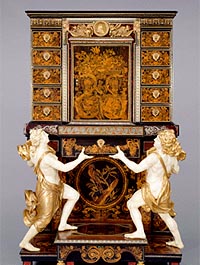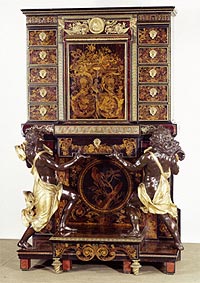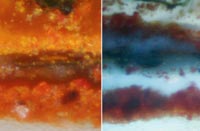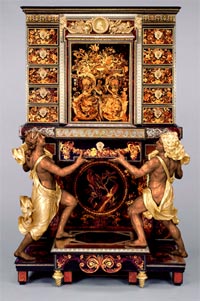 |
 |
 |
|
Date: Wednesday, January 25, 2006, 3:00 p.m.
Location: The Getty Center, Museum Lecture Hall
Admission: Free; reservations required.
Arlen Heginbotham, associate conservator of decorative arts at the J. Paul Getty Museum, shares new discoveries about this cabinet in an illustrated lecture open to Getty staff and colleagues.
The cabinet's fascinating story shows how scientific and archival research can transform our understanding of important works of art and lead us to a fuller appreciation of their makers' techniques and intentions.
|
 |

|
 |
 |
 |
|
The Object
This extraordinary cabinet-on-stand became part of the Getty Museum's collection in 1977. It is one of a pair attributed to André-Charles Boulle, cabinetmaker to Louis XIV of France.
The mate survives at Drumlanrig Castle in Scotland.
The Mystery
The unusual carved figures supporting the front corners of the Getty cabinet are said to represent Hercules and Hypolita. In 1977, the skin of these figures was dark brown and thought to be in imitation of bronze (photo, right).
However, as restorers in London worked on the piece before shipping it to the museum, they discovered that this dark skin tone was the result of numerous layers of paint added by previous restorers over the years. The first layer of paint on the figures was actually white, perhaps in imitation of marble.
The figures were stripped down to their white surface, which is how they are exhibited today (see photo at the top of the page).
|
 |


|
|
The Investigation
Heginbotham and other conservators recently investigated the cabinet's mate, whose figures still have a dark brown surface.
The team analyzed seven tiny samples of paint and gilding from the figures and examined them using scanning electron microscopy, immunofluorescence microscopy, and other scientific methods (photo, right).
|
 |


|
|
The Result
The result? Both cabinets were almost certainly not white originally, but rather faux-bronzed using an unusual technique.
In European treatises and recipe books from the 1600s through the early 1900s, conservators found descriptions of faux-bronzing techniques that confirmed the technique they had postulated based on their scientific discoveries and offered clues to the aesthetic intent of the original craftsmen.
Conservators used what they learned in the lab and in the archives to produce this "virtual restoration" of what the cabinet probably looked like originally (photo, right).

About Arlen Heginbotham
Arlen Heginbotham is associate conservator of decorative arts and sculpture at the J. Paul Getty Museum. He has worked at the Yale Peabody Museum of Natural History, the Isabella Stuart Gardner Museum, and the Philadelphia Museum of Art, as well as in several private furniture conservation studios.
Heginbotham has published articles on subjects including gilding conservation, historic varnish preservation, the measurement of color fading, and adhesive testing. Heginbotham received his B.A. in East Asian Studies from Stanford University in 1989 and his M.A. in Art Conservation from Buffalo State College in 1999.
|
 |


|



